Analysis of Language Development Theories in Nursing: Textual Evidence
VerifiedAdded on 2022/10/15
|10
|2280
|15
Essay
AI Summary
This essay delves into the theories of language development relevant to nursing, examining behavioral, nativist, and interactionist perspectives. It analyzes a child's language through the lens of Halliday's theory, focusing on the child's pronunciation, lexicogrammar skills, and morphological knowledge. The assignment provides an overview of key concepts like phonological awareness, morphemic knowledge, and their role in language acquisition. The essay also discusses the critics of each theory, highlighting their strengths and weaknesses, and how they apply to the process of learning and language development in children. The essay concludes by reiterating the significance of various factors, including innate abilities, environment, memory, and cognitive capabilities, in shaping a child's learning trajectory.

Running head: NURSING
Learning and its therories
Name of the Student
Name of the University
Author’s note
Learning and its therories
Name of the Student
Name of the University
Author’s note
Paraphrase This Document
Need a fresh take? Get an instant paraphrase of this document with our AI Paraphraser

1
NURSING
Table of Contents
Introduction-...............................................................................................................................2
Behavioural therapy-..................................................................................................................2
Nativist theory............................................................................................................................3
Interactionist theory...................................................................................................................3
Child education through language.............................................................................................4
Child’s pronunciations...............................................................................................................4
Lexicogrammer skills of a child.................................................................................................5
Child’s morphological knowledge.............................................................................................6
Conclusion..................................................................................................................................6
References..................................................................................................................................8
NURSING
Table of Contents
Introduction-...............................................................................................................................2
Behavioural therapy-..................................................................................................................2
Nativist theory............................................................................................................................3
Interactionist theory...................................................................................................................3
Child education through language.............................................................................................4
Child’s pronunciations...............................................................................................................4
Lexicogrammer skills of a child.................................................................................................5
Child’s morphological knowledge.............................................................................................6
Conclusion..................................................................................................................................6
References..................................................................................................................................8

2
NURSING
Introduction-
According to Passarelli and Kolb (2016) learning is the process of acquiring
knowledge and developing the same with one’s own comprehensive skills and developmental
experiences. The cognition, memory and concentration of an individual largely guides the
process of learning. For the learning process, the child may be capable and competent. In this
assignment, the various theories proposed by individuals will be discussed. The behavioural
therapy refers to learning guided by training and environment, the nativist theory suggests
innate ability of an individual, and interactionist theory proposes interaction of both in the
learning process. Halliday proposed an elaborate method of teaching and learning which is
extremely significant from a child’s perspective. It is also delineated here that a child must be
sound in morphemes, lexicogrammar skills, and phenology for effective learning.
Behavioural therapy-
Behavioural therapy can also be referred to as psychotherapy that uses techniques to
manipulate the behavioural pattern of the individual. It is based on the theories of classical
and operant conditioning. B.F Skinner developed the initial idea. Verbal behavioural therapy
helps to develop comprehensive communication and language development skills. The main
characteristics of this therapy include it helps to interlink the words and reinforces the
purpose, teaches to obtain desired results (Zettle & Hayes 2015). The behavioural therapy
begins by teaching basic “mands” (one simple word), such as water. If the student learns to
speak the word, the therapist provides water and repeats it, to reinforce it. Then, the therapist
follows “tact”, i.e, he teaches to point and say an object’s name. After that, “intraverbal” is
followed where one word answer to a question can be given. “Echoic” is next used where
echoed or repeated sounds associated with the word is used. For example- When a cookie is
given, the therapist teaches to point and say cookie. Then teaches to answer of one word
NURSING
Introduction-
According to Passarelli and Kolb (2016) learning is the process of acquiring
knowledge and developing the same with one’s own comprehensive skills and developmental
experiences. The cognition, memory and concentration of an individual largely guides the
process of learning. For the learning process, the child may be capable and competent. In this
assignment, the various theories proposed by individuals will be discussed. The behavioural
therapy refers to learning guided by training and environment, the nativist theory suggests
innate ability of an individual, and interactionist theory proposes interaction of both in the
learning process. Halliday proposed an elaborate method of teaching and learning which is
extremely significant from a child’s perspective. It is also delineated here that a child must be
sound in morphemes, lexicogrammar skills, and phenology for effective learning.
Behavioural therapy-
Behavioural therapy can also be referred to as psychotherapy that uses techniques to
manipulate the behavioural pattern of the individual. It is based on the theories of classical
and operant conditioning. B.F Skinner developed the initial idea. Verbal behavioural therapy
helps to develop comprehensive communication and language development skills. The main
characteristics of this therapy include it helps to interlink the words and reinforces the
purpose, teaches to obtain desired results (Zettle & Hayes 2015). The behavioural therapy
begins by teaching basic “mands” (one simple word), such as water. If the student learns to
speak the word, the therapist provides water and repeats it, to reinforce it. Then, the therapist
follows “tact”, i.e, he teaches to point and say an object’s name. After that, “intraverbal” is
followed where one word answer to a question can be given. “Echoic” is next used where
echoed or repeated sounds associated with the word is used. For example- When a cookie is
given, the therapist teaches to point and say cookie. Then teaches to answer of one word
⊘ This is a preview!⊘
Do you want full access?
Subscribe today to unlock all pages.

Trusted by 1+ million students worldwide
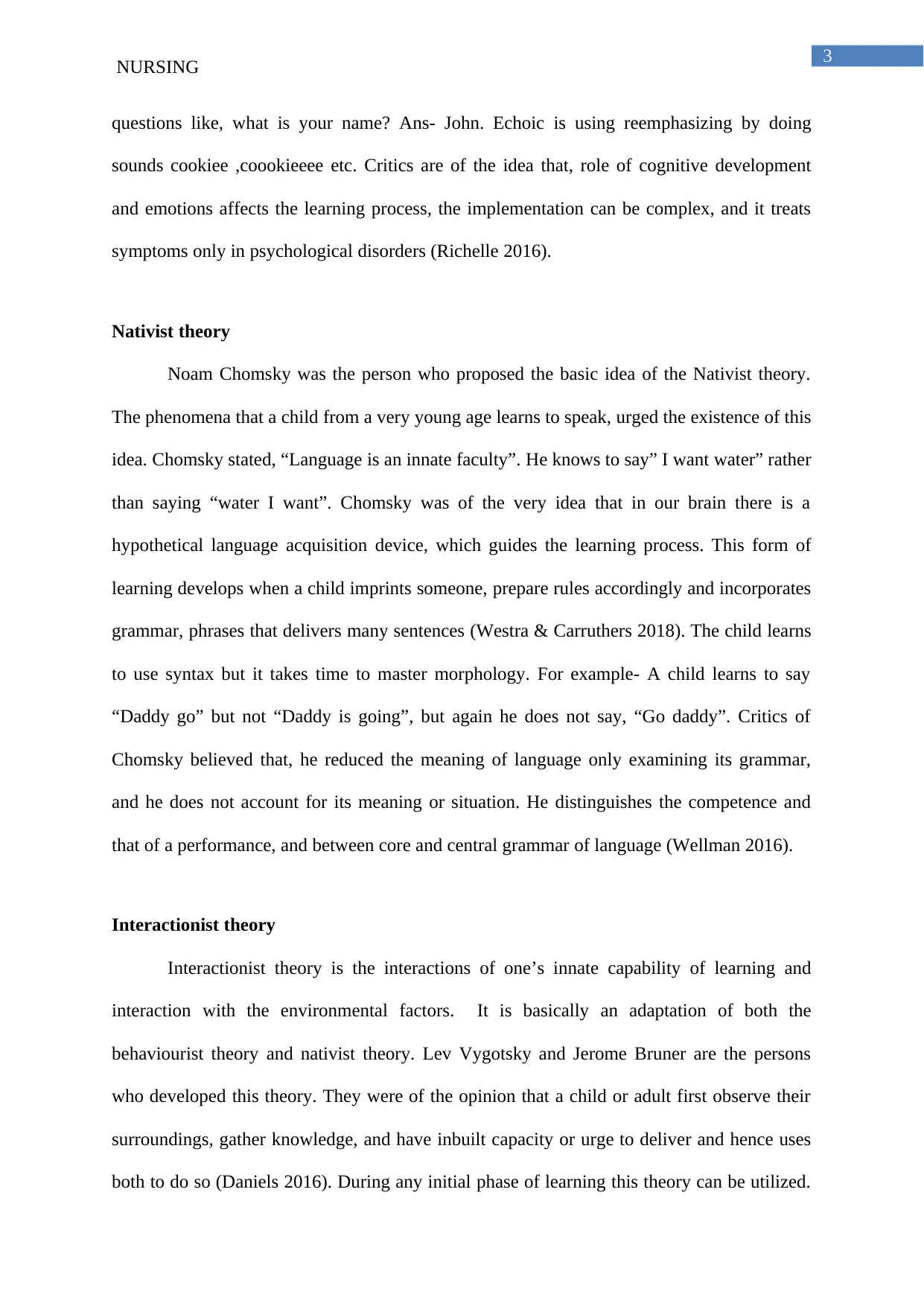
3
NURSING
questions like, what is your name? Ans- John. Echoic is using reemphasizing by doing
sounds cookiee ,coookieeee etc. Critics are of the idea that, role of cognitive development
and emotions affects the learning process, the implementation can be complex, and it treats
symptoms only in psychological disorders (Richelle 2016).
Nativist theory
Noam Chomsky was the person who proposed the basic idea of the Nativist theory.
The phenomena that a child from a very young age learns to speak, urged the existence of this
idea. Chomsky stated, “Language is an innate faculty”. He knows to say” I want water” rather
than saying “water I want”. Chomsky was of the very idea that in our brain there is a
hypothetical language acquisition device, which guides the learning process. This form of
learning develops when a child imprints someone, prepare rules accordingly and incorporates
grammar, phrases that delivers many sentences (Westra & Carruthers 2018). The child learns
to use syntax but it takes time to master morphology. For example- A child learns to say
“Daddy go” but not “Daddy is going”, but again he does not say, “Go daddy”. Critics of
Chomsky believed that, he reduced the meaning of language only examining its grammar,
and he does not account for its meaning or situation. He distinguishes the competence and
that of a performance, and between core and central grammar of language (Wellman 2016).
Interactionist theory
Interactionist theory is the interactions of one’s innate capability of learning and
interaction with the environmental factors. It is basically an adaptation of both the
behaviourist theory and nativist theory. Lev Vygotsky and Jerome Bruner are the persons
who developed this theory. They were of the opinion that a child or adult first observe their
surroundings, gather knowledge, and have inbuilt capacity or urge to deliver and hence uses
both to do so (Daniels 2016). During any initial phase of learning this theory can be utilized.
NURSING
questions like, what is your name? Ans- John. Echoic is using reemphasizing by doing
sounds cookiee ,coookieeee etc. Critics are of the idea that, role of cognitive development
and emotions affects the learning process, the implementation can be complex, and it treats
symptoms only in psychological disorders (Richelle 2016).
Nativist theory
Noam Chomsky was the person who proposed the basic idea of the Nativist theory.
The phenomena that a child from a very young age learns to speak, urged the existence of this
idea. Chomsky stated, “Language is an innate faculty”. He knows to say” I want water” rather
than saying “water I want”. Chomsky was of the very idea that in our brain there is a
hypothetical language acquisition device, which guides the learning process. This form of
learning develops when a child imprints someone, prepare rules accordingly and incorporates
grammar, phrases that delivers many sentences (Westra & Carruthers 2018). The child learns
to use syntax but it takes time to master morphology. For example- A child learns to say
“Daddy go” but not “Daddy is going”, but again he does not say, “Go daddy”. Critics of
Chomsky believed that, he reduced the meaning of language only examining its grammar,
and he does not account for its meaning or situation. He distinguishes the competence and
that of a performance, and between core and central grammar of language (Wellman 2016).
Interactionist theory
Interactionist theory is the interactions of one’s innate capability of learning and
interaction with the environmental factors. It is basically an adaptation of both the
behaviourist theory and nativist theory. Lev Vygotsky and Jerome Bruner are the persons
who developed this theory. They were of the opinion that a child or adult first observe their
surroundings, gather knowledge, and have inbuilt capacity or urge to deliver and hence uses
both to do so (Daniels 2016). During any initial phase of learning this theory can be utilized.
Paraphrase This Document
Need a fresh take? Get an instant paraphrase of this document with our AI Paraphraser
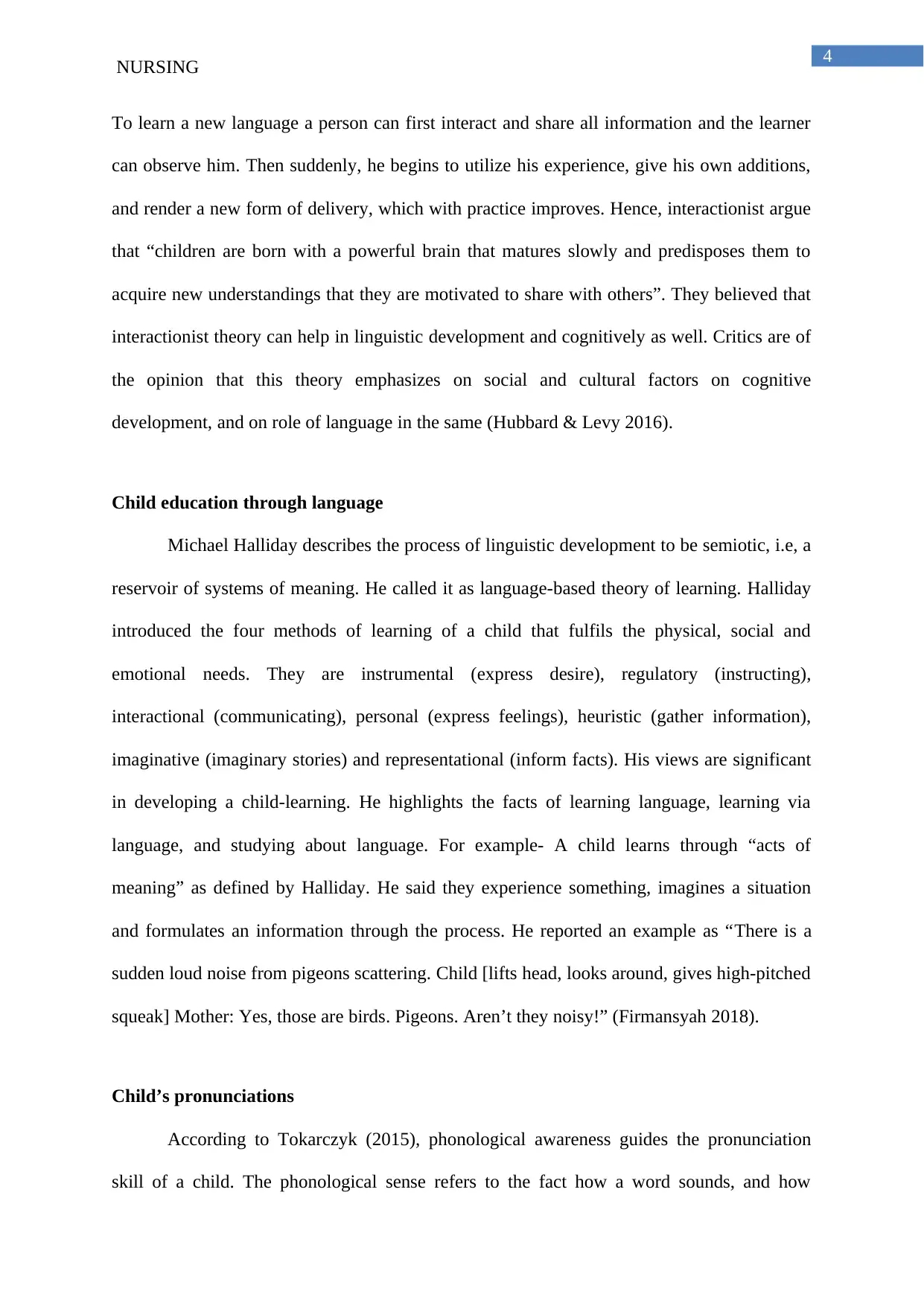
4
NURSING
To learn a new language a person can first interact and share all information and the learner
can observe him. Then suddenly, he begins to utilize his experience, give his own additions,
and render a new form of delivery, which with practice improves. Hence, interactionist argue
that “children are born with a powerful brain that matures slowly and predisposes them to
acquire new understandings that they are motivated to share with others”. They believed that
interactionist theory can help in linguistic development and cognitively as well. Critics are of
the opinion that this theory emphasizes on social and cultural factors on cognitive
development, and on role of language in the same (Hubbard & Levy 2016).
Child education through language
Michael Halliday describes the process of linguistic development to be semiotic, i.e, a
reservoir of systems of meaning. He called it as language-based theory of learning. Halliday
introduced the four methods of learning of a child that fulfils the physical, social and
emotional needs. They are instrumental (express desire), regulatory (instructing),
interactional (communicating), personal (express feelings), heuristic (gather information),
imaginative (imaginary stories) and representational (inform facts). His views are significant
in developing a child-learning. He highlights the facts of learning language, learning via
language, and studying about language. For example- A child learns through “acts of
meaning” as defined by Halliday. He said they experience something, imagines a situation
and formulates an information through the process. He reported an example as “There is a
sudden loud noise from pigeons scattering. Child [lifts head, looks around, gives high-pitched
squeak] Mother: Yes, those are birds. Pigeons. Aren’t they noisy!” (Firmansyah 2018).
Child’s pronunciations
According to Tokarczyk (2015), phonological awareness guides the pronunciation
skill of a child. The phonological sense refers to the fact how a word sounds, and how
NURSING
To learn a new language a person can first interact and share all information and the learner
can observe him. Then suddenly, he begins to utilize his experience, give his own additions,
and render a new form of delivery, which with practice improves. Hence, interactionist argue
that “children are born with a powerful brain that matures slowly and predisposes them to
acquire new understandings that they are motivated to share with others”. They believed that
interactionist theory can help in linguistic development and cognitively as well. Critics are of
the opinion that this theory emphasizes on social and cultural factors on cognitive
development, and on role of language in the same (Hubbard & Levy 2016).
Child education through language
Michael Halliday describes the process of linguistic development to be semiotic, i.e, a
reservoir of systems of meaning. He called it as language-based theory of learning. Halliday
introduced the four methods of learning of a child that fulfils the physical, social and
emotional needs. They are instrumental (express desire), regulatory (instructing),
interactional (communicating), personal (express feelings), heuristic (gather information),
imaginative (imaginary stories) and representational (inform facts). His views are significant
in developing a child-learning. He highlights the facts of learning language, learning via
language, and studying about language. For example- A child learns through “acts of
meaning” as defined by Halliday. He said they experience something, imagines a situation
and formulates an information through the process. He reported an example as “There is a
sudden loud noise from pigeons scattering. Child [lifts head, looks around, gives high-pitched
squeak] Mother: Yes, those are birds. Pigeons. Aren’t they noisy!” (Firmansyah 2018).
Child’s pronunciations
According to Tokarczyk (2015), phonological awareness guides the pronunciation
skill of a child. The phonological sense refers to the fact how a word sounds, and how
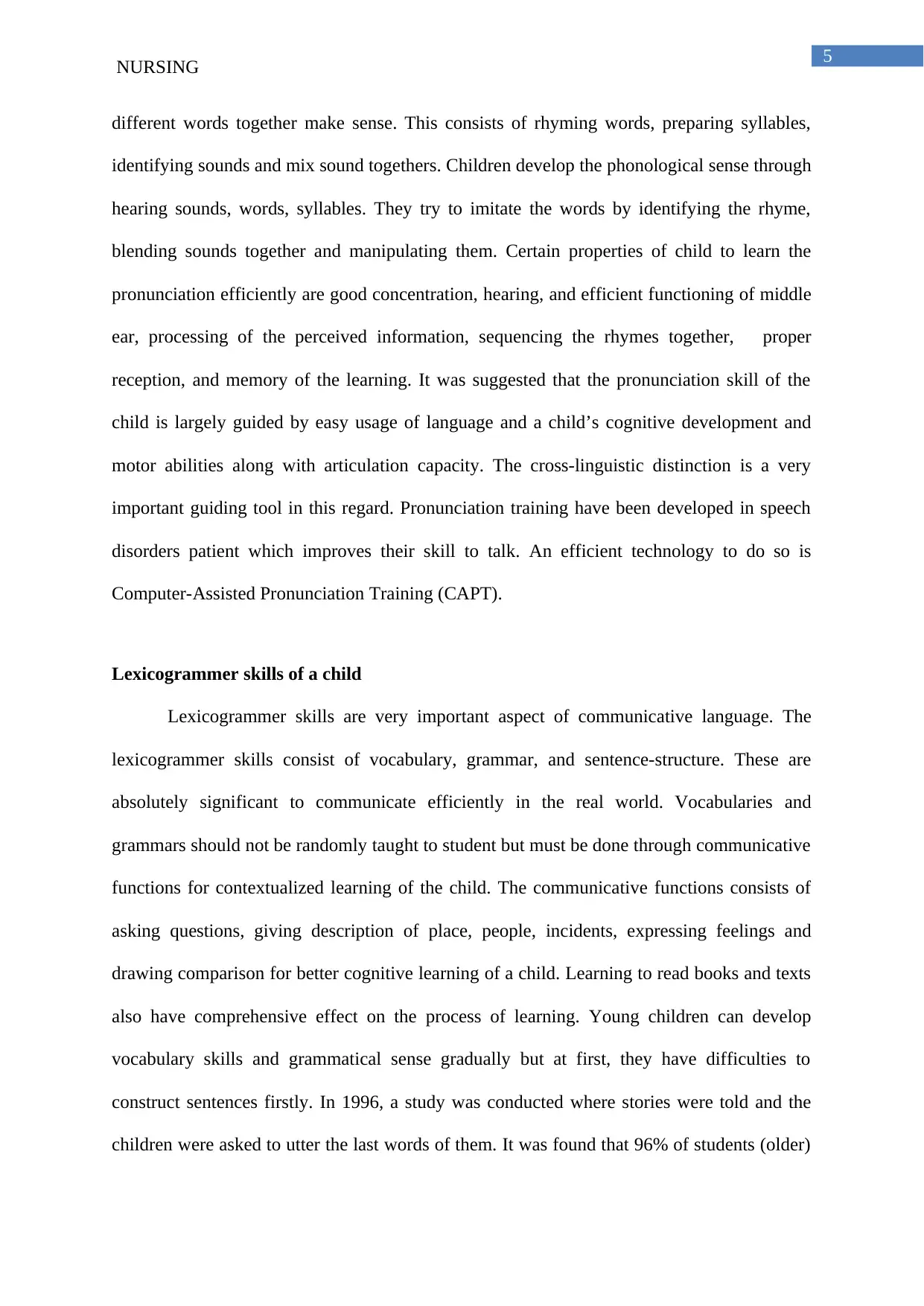
5
NURSING
different words together make sense. This consists of rhyming words, preparing syllables,
identifying sounds and mix sound togethers. Children develop the phonological sense through
hearing sounds, words, syllables. They try to imitate the words by identifying the rhyme,
blending sounds together and manipulating them. Certain properties of child to learn the
pronunciation efficiently are good concentration, hearing, and efficient functioning of middle
ear, processing of the perceived information, sequencing the rhymes together, proper
reception, and memory of the learning. It was suggested that the pronunciation skill of the
child is largely guided by easy usage of language and a child’s cognitive development and
motor abilities along with articulation capacity. The cross-linguistic distinction is a very
important guiding tool in this regard. Pronunciation training have been developed in speech
disorders patient which improves their skill to talk. An efficient technology to do so is
Computer-Assisted Pronunciation Training (CAPT).
Lexicogrammer skills of a child
Lexicogrammer skills are very important aspect of communicative language. The
lexicogrammer skills consist of vocabulary, grammar, and sentence-structure. These are
absolutely significant to communicate efficiently in the real world. Vocabularies and
grammars should not be randomly taught to student but must be done through communicative
functions for contextualized learning of the child. The communicative functions consists of
asking questions, giving description of place, people, incidents, expressing feelings and
drawing comparison for better cognitive learning of a child. Learning to read books and texts
also have comprehensive effect on the process of learning. Young children can develop
vocabulary skills and grammatical sense gradually but at first, they have difficulties to
construct sentences firstly. In 1996, a study was conducted where stories were told and the
children were asked to utter the last words of them. It was found that 96% of students (older)
NURSING
different words together make sense. This consists of rhyming words, preparing syllables,
identifying sounds and mix sound togethers. Children develop the phonological sense through
hearing sounds, words, syllables. They try to imitate the words by identifying the rhyme,
blending sounds together and manipulating them. Certain properties of child to learn the
pronunciation efficiently are good concentration, hearing, and efficient functioning of middle
ear, processing of the perceived information, sequencing the rhymes together, proper
reception, and memory of the learning. It was suggested that the pronunciation skill of the
child is largely guided by easy usage of language and a child’s cognitive development and
motor abilities along with articulation capacity. The cross-linguistic distinction is a very
important guiding tool in this regard. Pronunciation training have been developed in speech
disorders patient which improves their skill to talk. An efficient technology to do so is
Computer-Assisted Pronunciation Training (CAPT).
Lexicogrammer skills of a child
Lexicogrammer skills are very important aspect of communicative language. The
lexicogrammer skills consist of vocabulary, grammar, and sentence-structure. These are
absolutely significant to communicate efficiently in the real world. Vocabularies and
grammars should not be randomly taught to student but must be done through communicative
functions for contextualized learning of the child. The communicative functions consists of
asking questions, giving description of place, people, incidents, expressing feelings and
drawing comparison for better cognitive learning of a child. Learning to read books and texts
also have comprehensive effect on the process of learning. Young children can develop
vocabulary skills and grammatical sense gradually but at first, they have difficulties to
construct sentences firstly. In 1996, a study was conducted where stories were told and the
children were asked to utter the last words of them. It was found that 96% of students (older)
⊘ This is a preview!⊘
Do you want full access?
Subscribe today to unlock all pages.

Trusted by 1+ million students worldwide
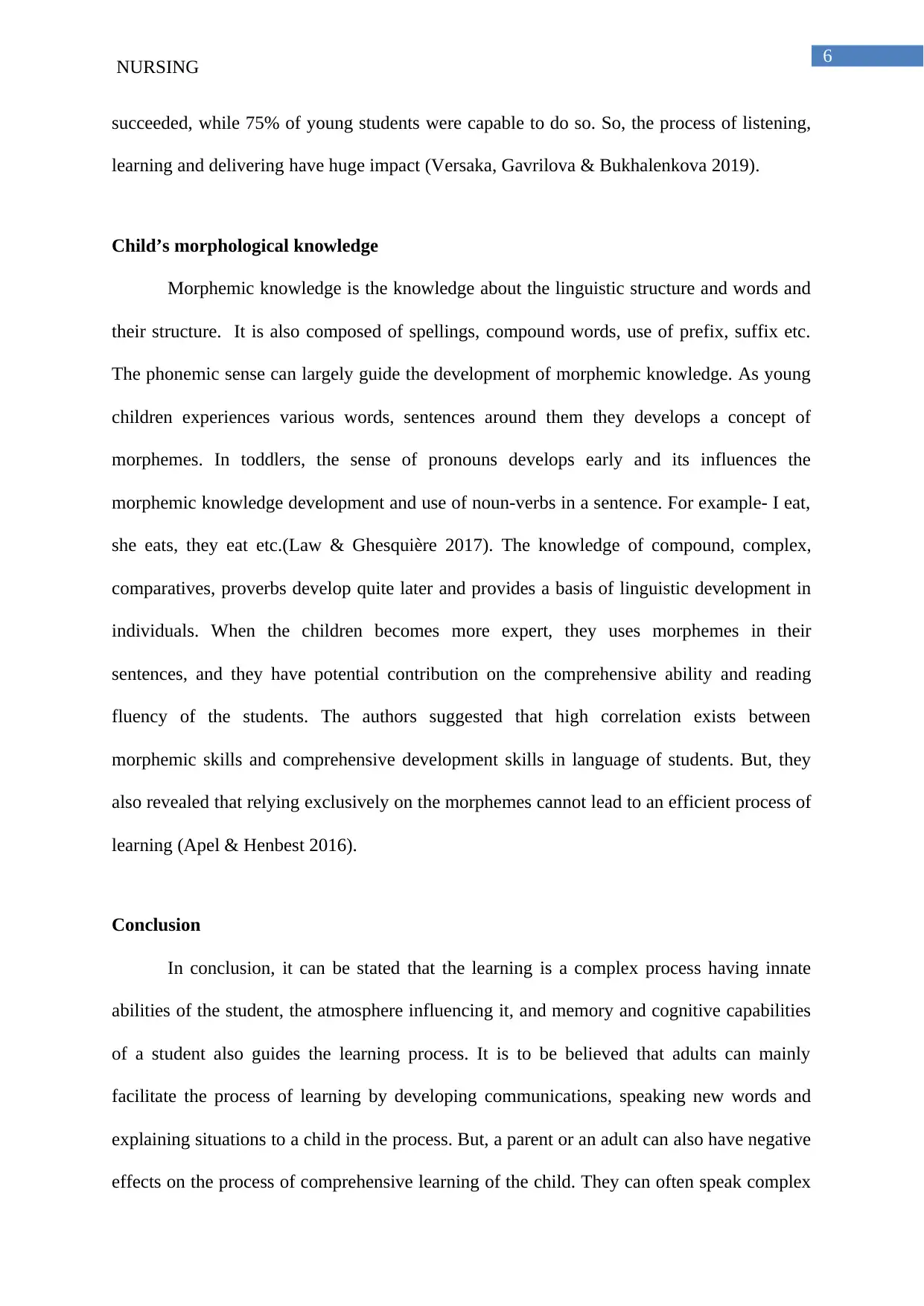
6
NURSING
succeeded, while 75% of young students were capable to do so. So, the process of listening,
learning and delivering have huge impact (Versaka, Gavrilova & Bukhalenkova 2019).
Child’s morphological knowledge
Morphemic knowledge is the knowledge about the linguistic structure and words and
their structure. It is also composed of spellings, compound words, use of prefix, suffix etc.
The phonemic sense can largely guide the development of morphemic knowledge. As young
children experiences various words, sentences around them they develops a concept of
morphemes. In toddlers, the sense of pronouns develops early and its influences the
morphemic knowledge development and use of noun-verbs in a sentence. For example- I eat,
she eats, they eat etc.(Law & Ghesquière 2017). The knowledge of compound, complex,
comparatives, proverbs develop quite later and provides a basis of linguistic development in
individuals. When the children becomes more expert, they uses morphemes in their
sentences, and they have potential contribution on the comprehensive ability and reading
fluency of the students. The authors suggested that high correlation exists between
morphemic skills and comprehensive development skills in language of students. But, they
also revealed that relying exclusively on the morphemes cannot lead to an efficient process of
learning (Apel & Henbest 2016).
Conclusion
In conclusion, it can be stated that the learning is a complex process having innate
abilities of the student, the atmosphere influencing it, and memory and cognitive capabilities
of a student also guides the learning process. It is to be believed that adults can mainly
facilitate the process of learning by developing communications, speaking new words and
explaining situations to a child in the process. But, a parent or an adult can also have negative
effects on the process of comprehensive learning of the child. They can often speak complex
NURSING
succeeded, while 75% of young students were capable to do so. So, the process of listening,
learning and delivering have huge impact (Versaka, Gavrilova & Bukhalenkova 2019).
Child’s morphological knowledge
Morphemic knowledge is the knowledge about the linguistic structure and words and
their structure. It is also composed of spellings, compound words, use of prefix, suffix etc.
The phonemic sense can largely guide the development of morphemic knowledge. As young
children experiences various words, sentences around them they develops a concept of
morphemes. In toddlers, the sense of pronouns develops early and its influences the
morphemic knowledge development and use of noun-verbs in a sentence. For example- I eat,
she eats, they eat etc.(Law & Ghesquière 2017). The knowledge of compound, complex,
comparatives, proverbs develop quite later and provides a basis of linguistic development in
individuals. When the children becomes more expert, they uses morphemes in their
sentences, and they have potential contribution on the comprehensive ability and reading
fluency of the students. The authors suggested that high correlation exists between
morphemic skills and comprehensive development skills in language of students. But, they
also revealed that relying exclusively on the morphemes cannot lead to an efficient process of
learning (Apel & Henbest 2016).
Conclusion
In conclusion, it can be stated that the learning is a complex process having innate
abilities of the student, the atmosphere influencing it, and memory and cognitive capabilities
of a student also guides the learning process. It is to be believed that adults can mainly
facilitate the process of learning by developing communications, speaking new words and
explaining situations to a child in the process. But, a parent or an adult can also have negative
effects on the process of comprehensive learning of the child. They can often speak complex
Paraphrase This Document
Need a fresh take? Get an instant paraphrase of this document with our AI Paraphraser
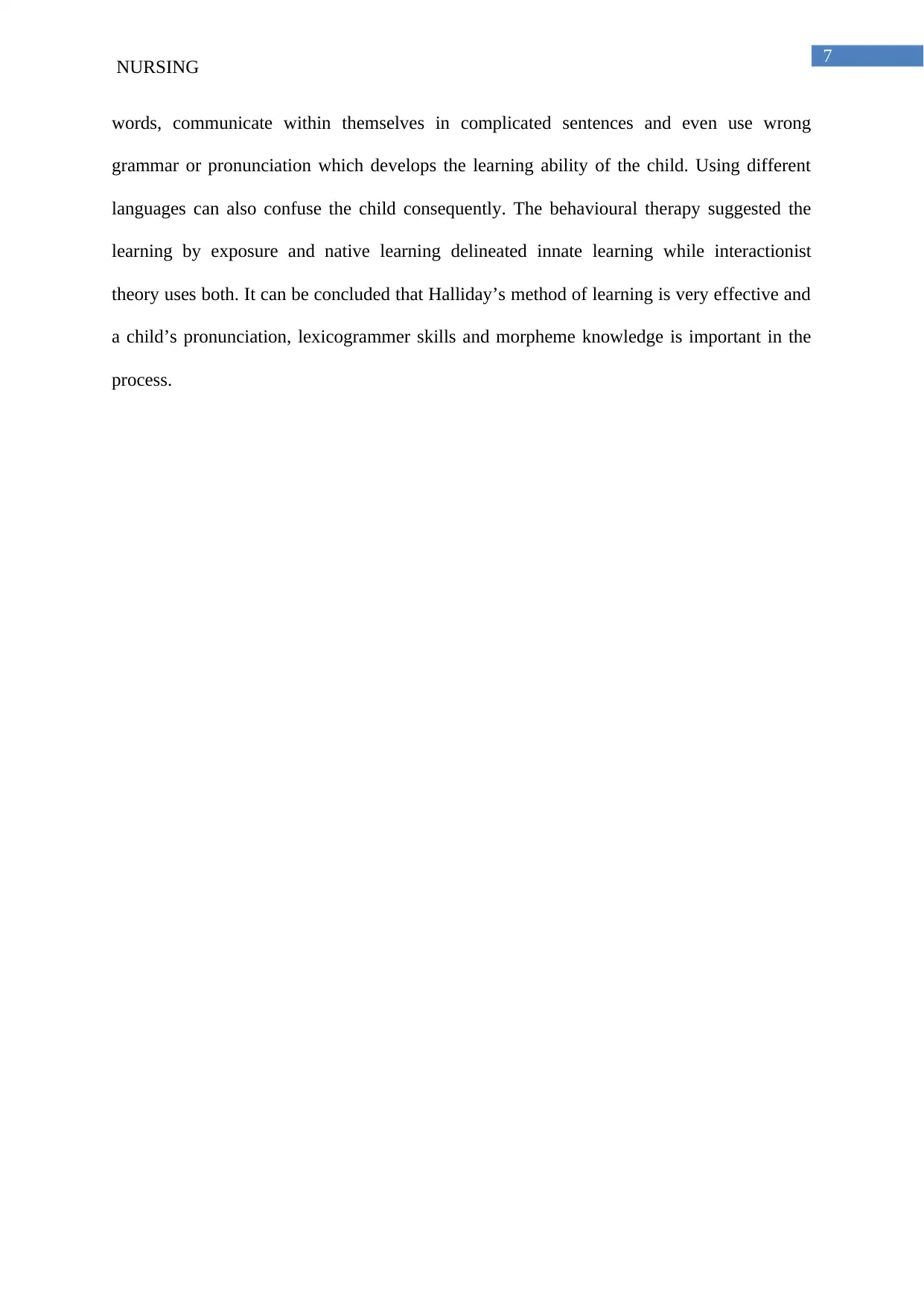
7
NURSING
words, communicate within themselves in complicated sentences and even use wrong
grammar or pronunciation which develops the learning ability of the child. Using different
languages can also confuse the child consequently. The behavioural therapy suggested the
learning by exposure and native learning delineated innate learning while interactionist
theory uses both. It can be concluded that Halliday’s method of learning is very effective and
a child’s pronunciation, lexicogrammer skills and morpheme knowledge is important in the
process.
NURSING
words, communicate within themselves in complicated sentences and even use wrong
grammar or pronunciation which develops the learning ability of the child. Using different
languages can also confuse the child consequently. The behavioural therapy suggested the
learning by exposure and native learning delineated innate learning while interactionist
theory uses both. It can be concluded that Halliday’s method of learning is very effective and
a child’s pronunciation, lexicogrammer skills and morpheme knowledge is important in the
process.
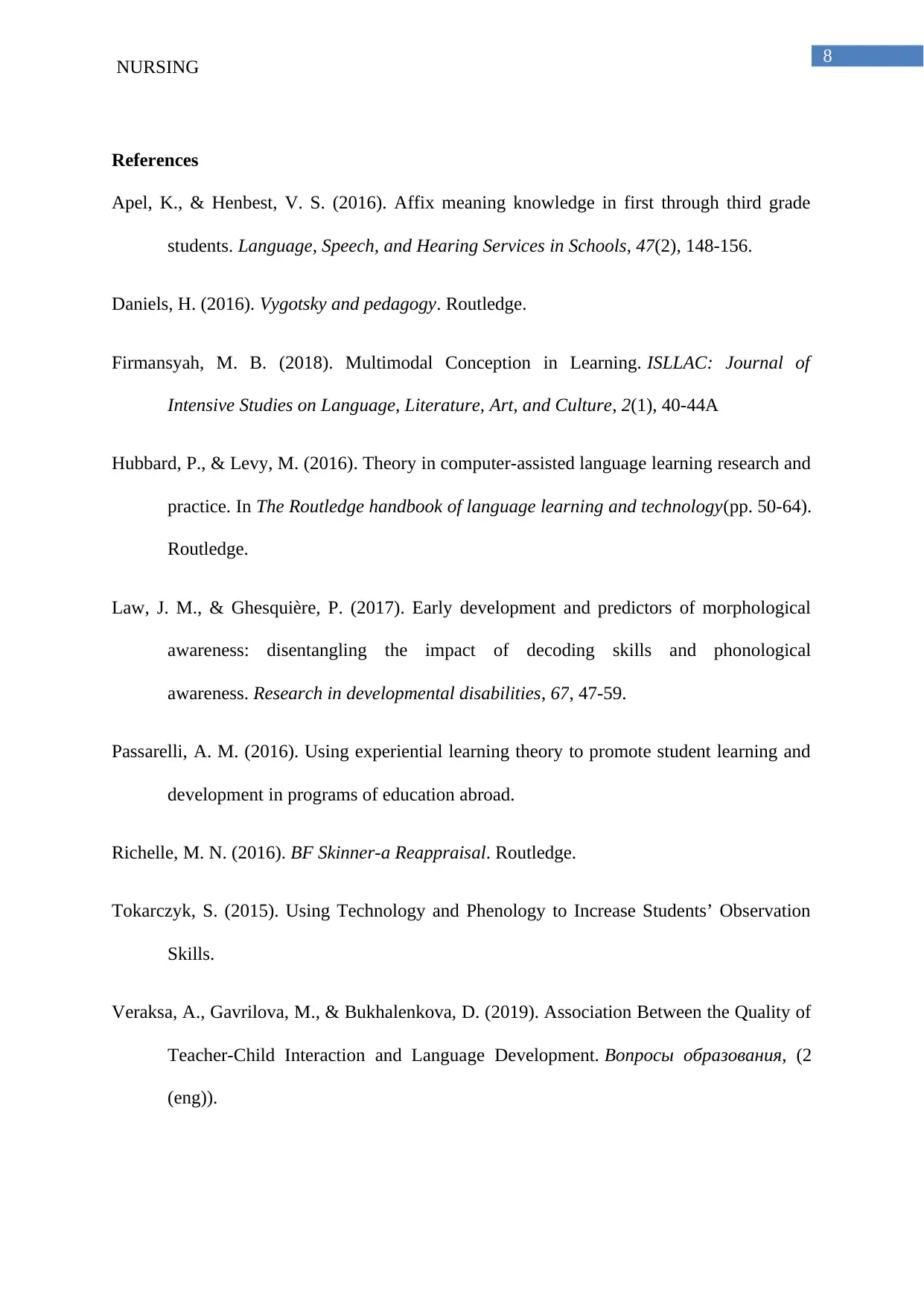
8
NURSING
References
Apel, K., & Henbest, V. S. (2016). Affix meaning knowledge in first through third grade
students. Language, Speech, and Hearing Services in Schools, 47(2), 148-156.
Daniels, H. (2016). Vygotsky and pedagogy. Routledge.
Firmansyah, M. B. (2018). Multimodal Conception in Learning. ISLLAC: Journal of
Intensive Studies on Language, Literature, Art, and Culture, 2(1), 40-44A
Hubbard, P., & Levy, M. (2016). Theory in computer-assisted language learning research and
practice. In The Routledge handbook of language learning and technology(pp. 50-64).
Routledge.
Law, J. M., & Ghesquière, P. (2017). Early development and predictors of morphological
awareness: disentangling the impact of decoding skills and phonological
awareness. Research in developmental disabilities, 67, 47-59.
Passarelli, A. M. (2016). Using experiential learning theory to promote student learning and
development in programs of education abroad.
Richelle, M. N. (2016). BF Skinner-a Reappraisal. Routledge.
Tokarczyk, S. (2015). Using Technology and Phenology to Increase Students’ Observation
Skills.
Veraksa, A., Gavrilova, M., & Bukhalenkova, D. (2019). Association Between the Quality of
Teacher-Child Interaction and Language Development. Вопросы образования, (2
(eng)).
NURSING
References
Apel, K., & Henbest, V. S. (2016). Affix meaning knowledge in first through third grade
students. Language, Speech, and Hearing Services in Schools, 47(2), 148-156.
Daniels, H. (2016). Vygotsky and pedagogy. Routledge.
Firmansyah, M. B. (2018). Multimodal Conception in Learning. ISLLAC: Journal of
Intensive Studies on Language, Literature, Art, and Culture, 2(1), 40-44A
Hubbard, P., & Levy, M. (2016). Theory in computer-assisted language learning research and
practice. In The Routledge handbook of language learning and technology(pp. 50-64).
Routledge.
Law, J. M., & Ghesquière, P. (2017). Early development and predictors of morphological
awareness: disentangling the impact of decoding skills and phonological
awareness. Research in developmental disabilities, 67, 47-59.
Passarelli, A. M. (2016). Using experiential learning theory to promote student learning and
development in programs of education abroad.
Richelle, M. N. (2016). BF Skinner-a Reappraisal. Routledge.
Tokarczyk, S. (2015). Using Technology and Phenology to Increase Students’ Observation
Skills.
Veraksa, A., Gavrilova, M., & Bukhalenkova, D. (2019). Association Between the Quality of
Teacher-Child Interaction and Language Development. Вопросы образования, (2
(eng)).
⊘ This is a preview!⊘
Do you want full access?
Subscribe today to unlock all pages.

Trusted by 1+ million students worldwide

9
NURSING
Wellman, H. M. (2016). Learning a theory of mind. In Theory of mind development in
context (pp. 23-44). Routledge.
Westra, E., & Carruthers, P. (2018). Theory of Mind.
Zettle, R. D., & Hayes, S. C. (2015). Rule-governed behavior: A potential theoretical
framework for cognitive-behavioral therapy. In The Act in Context (pp. 33-63).
Routledge.
NURSING
Wellman, H. M. (2016). Learning a theory of mind. In Theory of mind development in
context (pp. 23-44). Routledge.
Westra, E., & Carruthers, P. (2018). Theory of Mind.
Zettle, R. D., & Hayes, S. C. (2015). Rule-governed behavior: A potential theoretical
framework for cognitive-behavioral therapy. In The Act in Context (pp. 33-63).
Routledge.
1 out of 10
Related Documents
Your All-in-One AI-Powered Toolkit for Academic Success.
+13062052269
info@desklib.com
Available 24*7 on WhatsApp / Email
![[object Object]](/_next/static/media/star-bottom.7253800d.svg)
Unlock your academic potential
Copyright © 2020–2025 A2Z Services. All Rights Reserved. Developed and managed by ZUCOL.




